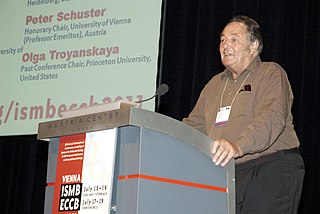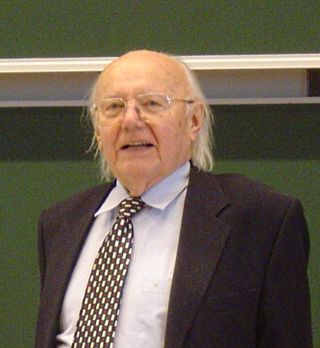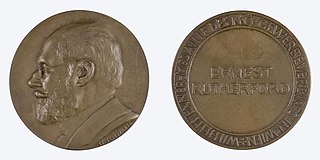
Max Ferdinand Perutz was an Austrian-born British molecular biologist, who shared the 1962 Nobel Prize for Chemistry with John Kendrew, for their studies of the structures of haemoglobin and myoglobin. He went on to win the Royal Medal of the Royal Society in 1971 and the Copley Medal in 1979. At Cambridge he founded and chaired (1962–79) The MRC Laboratory of Molecular Biology (LMB), fourteen of whose scientists have won Nobel Prizes.

Frederick Sanger was a British biochemist who received the Nobel Prize in Chemistry twice.

Alfred Kastler was a French physicist, and Nobel Prize laureate. He is known for the development of optical pumping.

Peter K. Schuster is a theoretical chemist known for his work with the German Nobel Laureate Manfred Eigen in developing the quasispecies model. His work has made great strides in the understanding of viruses and their replication, as well as theoretical mechanisms in the origin of life.

Edmund Hlawka was an Austrian mathematician. He was a leading number theorist. Hlawka did most of his work at the Vienna University of Technology. He was also a visiting professor at Princeton University and the Sorbonne. Hlawka died on February 19, 2009, in Vienna.

Heinz Zemanek was an Austrian computer pioneer who led the development, from 1954 to 1958, of one of the first complete transistorised computers on the European continent. The computer was nicknamed Mailüfterl — Viennese for "May breeze" — in reference to Whirlwind, a computer developed at MIT between 1945 and 1951.
The Ignaz Lieben Prize, named after the Austrian banker Ignaz Lieben, is an annual Austrian award made by the Austrian Academy of Sciences to young scientists working in the fields of molecular biology, chemistry, or physics.

Herman Francis Mark was an Austrian-American chemist regarded for his contributions to the development of polymer science. Mark's x-ray diffraction work on the molecular structure of fibers provided important evidence for the macromolecular theory of polymer structure. Together with Houwink he formulated an equation, now called the Mark–Houwink or Mark–Houwink–Sakurada equation, describing the dependence of the intrinsic viscosity of a polymer on its relative molecular mass. He was a long-time faculty at Polytechnic Institute of Brooklyn. In 1946, he established the Journal of Polymer Science.

Meir Wilchek is an Israeli biochemist. He is a professor at the Weizmann Institute of Science.

Günther Wilke was a German chemist who was influential in organometallic chemistry. He was the director of the Max Planck Institute for Coal Research from 1967–1992, succeeding Karl Ziegler in that post. During Wilke's era, the MPI made several discoveries and achieved some financial independence from patents and a gift from the Ziegler family. The institute continued as a center of excellence in organometallic chemistry.

Karl Schlögl was professor of organic chemistry at the University of Vienna and secretary as well as vice-president of the Austrian Academy of Sciences.

Michael Grätzel is a professor at the École Polytechnique Fédérale de Lausanne where he directs the Laboratory of Photonics and Interfaces. He pioneered research on energy and electron transfer reactions in mesoscopic-materials and their optoelectronic applications. He co-invented with Brian O'Regan the Grätzel cell in 1988.

Gottfried Schatz was a Swiss-Austrian biochemist.
Helmut Zahn was a German chemist who is often credited as the first to synthesize Insulin in 1963. His results synthesizing insulin were achieved almost simultaneously with that of Panayotis Katsoyannis at the University of Pittsburgh. His work was not honoured by the Nobel prize because in 1958 Frederick Sanger was the first who discovered the chemical structure of Insulin.

Karl Kordesch was an Austrian chemist and inventor, most notable for jointly inventing the alkaline battery. In 1953 he moved to the United States as part of Operation Paperclip.
Otto Kratky was an Austrian physicist. He is best known for his contribution to the small-angle X-ray scattering method, for the Kratky plot, and for the invention of the density metering using the oscillating u-tube principle. The worm-like chain model in polymer physics, introduced with Günther Porod in a 1949 paper, is also named the Kratky–Porod model.

The Wilhelm Exner Medal has been awarded by the Austrian Industry Association, Österreichischer Gewerbeverein (ÖGV), for excellence in research and science since 1921.

Renée Schroeder is an Austrian researcher and university professor at the Department of Biochemistry at the Max F. Perutz Laboratories of the University of Vienna and the Medical University of Vienna.

Denise P. Barlow was a British geneticist who worked in the field of epigenomics. Barlow was an elected member of European Molecular Biology Organization (EMBO), an honorary professor of genetics at the University of Vienna and recipient of the Erwin Schrödinger Prize of the Austrian Academy of Sciences. In 1991, she discovered the first mammalian imprinted gene, IGF2R, which codes for the insulin-like growth factor.
Arndt von Haeseler is a German bioinformatician and evolutionary biologist. He is the scientific director of the Max F. Perutz Laboratories at the Vienna Biocenter and a professor of bioinformatics at the University of Vienna and the Medical University of Vienna.















